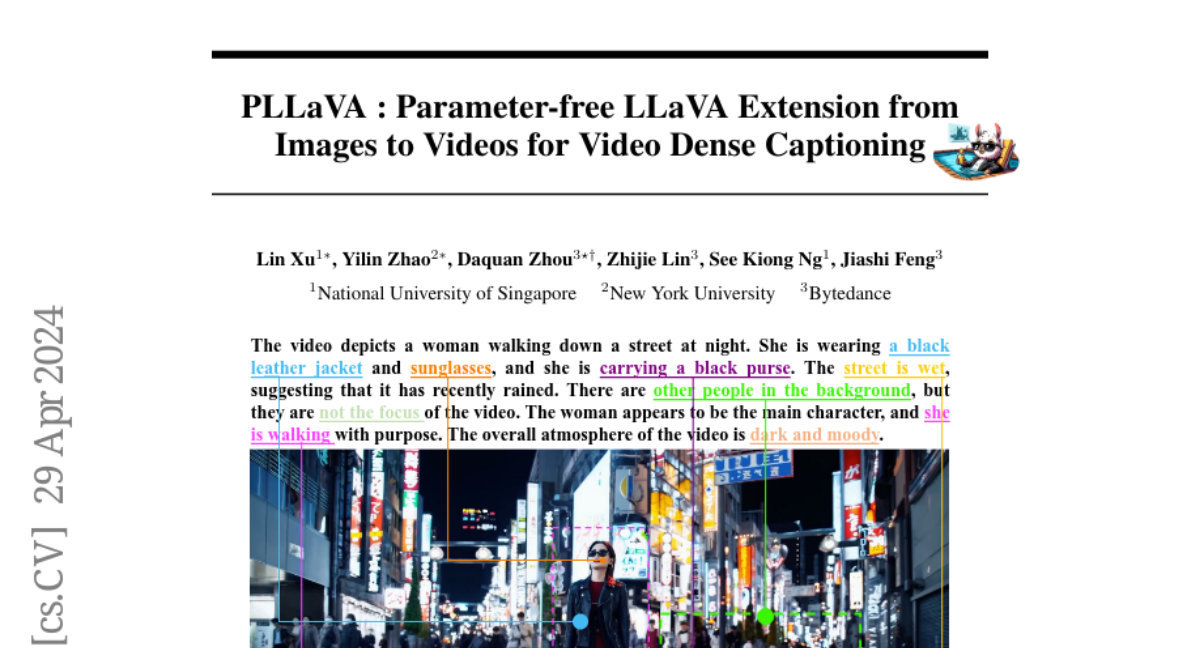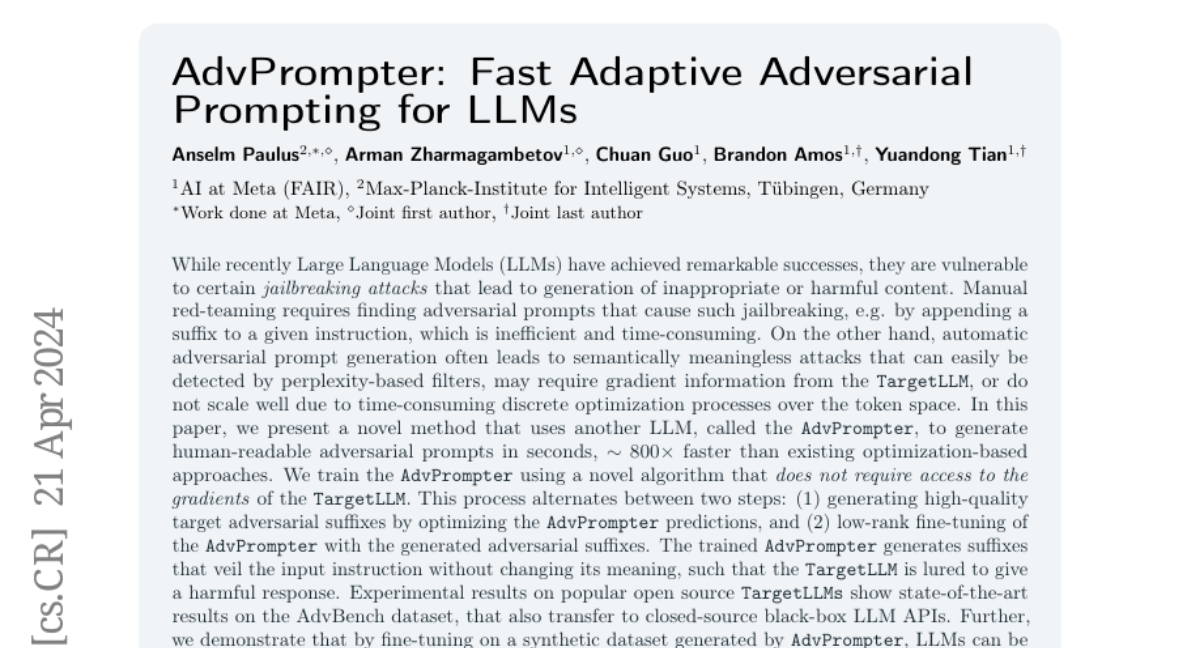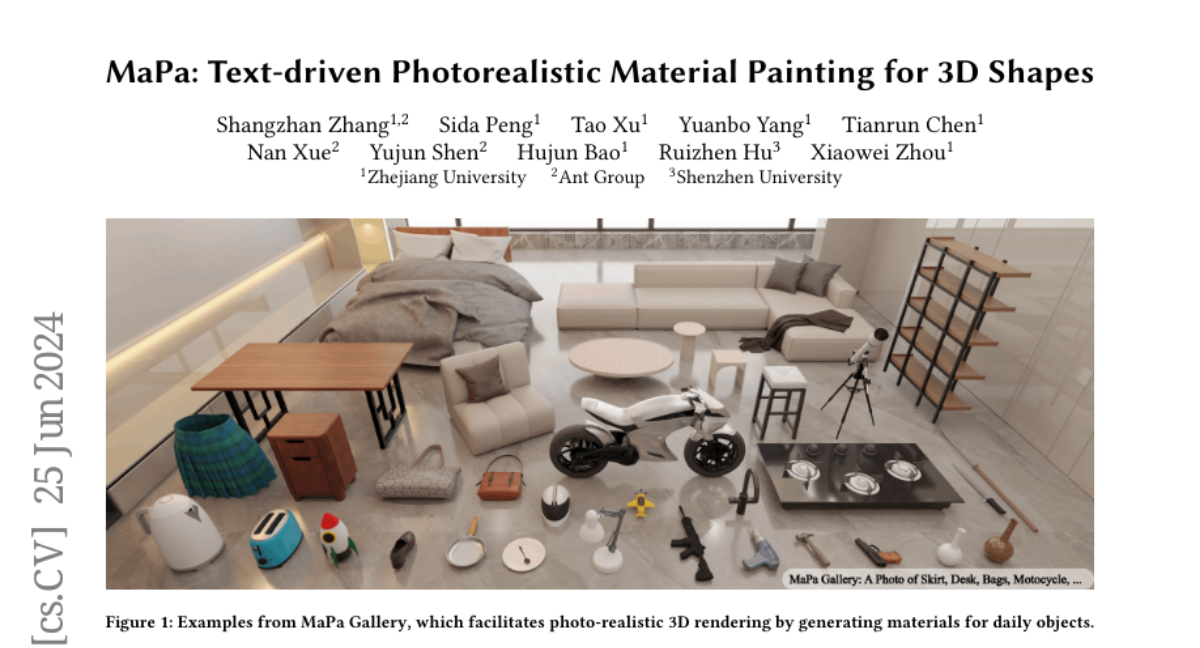PLLaVA : Parameter-free LLaVA Extension from Images to Videos for Video Dense Captioning

Vision-language pre-training has significantly elevated performance across a wide range of image-language applications. Yet, the pre-training process for video-related tasks demands exceptionally large computational and data resources, which hinders the progress of video-language models. This paper investigates a straightforward, highly efficient, and resource-light approach to adapting an existing image-language pre-trained model for dense video understanding. Our preliminary experiments reveal that directly fine-tuning pre-trained image-language models with multiple frames as inputs on video datasets leads to performance saturation or even a drop. Our further investigation reveals that it is largely attributed to the bias of learned high-norm visual features. Motivated by this finding, we propose a simple but effective pooling strategy to smooth the feature distribution along the temporal dimension and thus reduce the dominant impacts from the extreme features. The new model is termed Pooling LLaVA, or \nameofmethod{} in short. \nameofmethod{} achieves new state-of-the-art performance on modern benchmark datasets for both video question-answer and captioning tasks. Notably, on the recent popular Video ChatGPT benchmark, PLLaVA achieves a score of 3.48 out of 5 on average of five evaluated dimensions, exceeding the previous SOTA results from GPT4V (IG-VLM) by 9\%. On the latest multi-choice benchmark MVBench, PLLaVA achieves 58.1\% accuracy on average across 20 sub-tasks, 14.5\% higher than GPT4V (IG-VLM). Code is available at \url{https://github.com/magic-research/PLLaVA}.
AdvPrompter: Fast Adaptive Adversarial Prompting for LLMs

While recently Large Language Models (LLMs) have achieved remarkable successes, they are vulnerable to certain jailbreaking attacks that lead to generation of inappropriate or harmful content. Manual red-teaming requires finding adversarial prompts that cause such jailbreaking, e.g. by appending a suffix to a given instruction, which is inefficient and time-consuming. On the other hand, automatic adversarial prompt generation often leads to semantically meaningless attacks that can easily be detected by perplexity-based filters, may require gradient information from the TargetLLM, or do not scale well due to time-consuming discrete optimization processes over the token space. In this paper, we present a novel method that uses another LLM, called the AdvPrompter, to generate human-readable adversarial prompts in seconds, $\sim800\times$ faster than existing optimization-based approaches. We train the AdvPrompter using a novel algorithm that does not require access to the gradients of the TargetLLM. This process alternates between two steps: (1) generating high-quality target adversarial suffixes by optimizing the AdvPrompter predictions, and (2) low-rank fine-tuning of the AdvPrompter with the generated adversarial suffixes. The trained AdvPrompter generates suffixes that veil the input instruction without changing its meaning, such that the TargetLLM is lured to give a harmful response. Experimental results on popular open source TargetLLMs show state-of-the-art results on the AdvBench dataset, that also transfer to closed-source black-box LLM APIs. Further, we demonstrate that by fine-tuning on a synthetic dataset generated by AdvPrompter, LLMs can be made more robust against jailbreaking attacks while maintaining performance, i.e. high MMLU scores.
MaPa: Text-driven Photorealistic Material Painting for 3D Shapes

This paper aims to generate materials for 3D meshes from text descriptions. Unlike existing methods that synthesize texture maps, we propose to generate segment-wise procedural material graphs as the appearance representation, which supports high-quality rendering and provides substantial flexibility in editing. Instead of relying on extensive paired data, i.e., 3D meshes with material graphs and corresponding text descriptions, to train a material graph generative model, we propose to leverage the pre-trained 2D diffusion model as a bridge to connect the text and material graphs. Specifically, our approach decomposes a shape into a set of segments and designs a segment-controlled diffusion model to synthesize 2D images that are aligned with mesh parts. Based on generated images, we initialize parameters of material graphs and fine-tune them through the differentiable rendering module to produce materials in accordance with the textual description. Extensive experiments demonstrate the superior performance of our framework in photorealism, resolution, and editability over existing methods. Project page: https://zhanghe3z.github.io/MaPa/
HaLo-NeRF: Learning Geometry-Guided Semantics for Exploring Unconstrained Photo Collections

Internet image collections containing photos captured by crowds of photographers show promise for enabling digital exploration of large-scale tourist landmarks. However, prior works focus primarily on geometric reconstruction and visualization, neglecting the key role of language in providing a semantic interface for navigation and fine-grained understanding. In constrained 3D domains, recent methods have leveraged vision-and-language models as a strong prior of 2D visual semantics. While these models display an excellent understanding of broad visual semantics, they struggle with unconstrained photo collections depicting such tourist landmarks, as they lack expert knowledge of the architectural domain. In this work, we present a localization system that connects neural representations of scenes depicting large-scale landmarks with text describing a semantic region within the scene, by harnessing the power of SOTA vision-and-language models with adaptations for understanding landmark scene semantics. To bolster such models with fine-grained knowledge, we leverage large-scale Internet data containing images of similar landmarks along with weakly-related textual information. Our approach is built upon the premise that images physically grounded in space can provide a powerful supervision signal for localizing new concepts, whose semantics may be unlocked from Internet textual metadata with large language models. We use correspondences between views of scenes to bootstrap spatial understanding of these semantics, providing guidance for 3D-compatible segmentation that ultimately lifts to a volumetric scene representation. Our results show that HaLo-NeRF can accurately localize a variety of semantic concepts related to architectural landmarks, surpassing the results of other 3D models as well as strong 2D segmentation baselines. Our project page is at https://tau-vailab.github.io/HaLo-NeRF/.